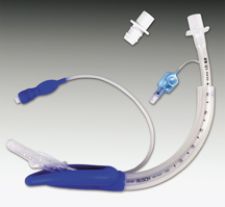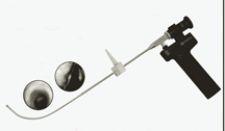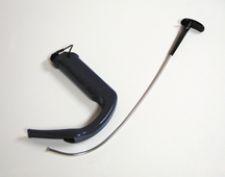
The Cook Gas ILA intubating laryngeal airway and removal stylet are distributed by Mercury Medical.
On any given day, a car accident victim will suffer a C-spine injury. A morbidly obese individual with a history of COPD may complain of chest pain, or an inner-city youth will come face to face with the wrong end of a handgun.
While seemingly unrelated, all three patients will arrive at their local ED and pose a distinct medical challenge that is independent of their particular injuries: a difficult airway.
“The No. 1 priority in resuscitating emergency patients is managing the airway,” explained Michael F. Murphy, M.D., professor and chair of Anesthesiology, professor of Emergency Medicine, Dalhousie University, and one of the founding faculty members for The Difficult Airway Courses. “Oxygen must get into the lungs, the bloodstream and to the brain.”
The best way to do this, he says, is to quickly evaluate patients and ascertain their airway status: (1.) Is the patient difficult to bag-mask ventilate? (2.) If so, will it be difficult to use an extra-glottic device? (3.) Will this be a difficult layrngoscopy and intubation? (4.) If necessary, will it be possible to perform a surgical airway?
“In an emergency situation, you must gather your wits and make solid decisions quickly and act on them. You must pick the most successful method first because you may only get one crack at it,” stressed Dr. Murphy.
Practice Makes Perfect
In order to guarantee the best possible outcome, practitioners must possess hands-on familiarity with the range of airway management tools and devices available.
“During a crisis is not the time to try out a new device,” Thomas Mort, M.D., an anesthesiologist and intensivist at Hartford Hospital, Hartford, CT, cautioned attendees at a recent SCCM difficult airway course.
The key to successful airway management is practice, practice and more practice, he says. This can be especially true for ED docs who don’t share anestheseologists’ airway experience and training.
Today’s better technology and better algorithms have allowed airway management to graduate from the “tube and run” approach to one that involves assessing, evaluating and preparing the patient. If laryngoscopy and mask ventilation are not going to work, you must have a strategic plan on how to smoothly proceed, explains Dr. Mort. Ongoing familiarization with difficult airway algorithms (such as those developed by the ASA) facilitates this new approach.
Algorithms, according to Dr. Murphy, are memory aids based on best practices and best evidence that guide the user through the airway management process to optimize the chances of success. While Dr. Mort relies on the ASA’s algorithms, Dr. Murphy prefers the Airway Management Education Center’s mini algorithms, such as the difficult airway algorithm, the failed airway algorithm and the crash airway algorithm — all of which are constructed with limited options for each step, thus allowing the practitioner to rapidly move through the steps.
Stacking the Odds
Algorithms, however, are just part of the solution. Advanced airway equipment must be readily available.
When it comes to stocking the difficult airway cart, a variety of devices should be considered. Drs. Murphy and Mort agree that the inexpensive bougie or intubating stylet is a fundamental piece of airway equipment that should be on every cart because it allows the user to fish a tube into the airway with limited movement to the patient’s neck. In addition, devices that are able to see around corners, says Dr. Murphy, are valuable additions and can range from more expensive technologies, such as the Glidescope and the Videolaryngoscope, to less expensive rigid stylets, such as the Shikani and Levitan.
“As you develop your difficult airway cart, you absolutely also need some type of extra-glottic device,” said Dr. Murphy.
The Airway Management Education Center recommends both intubating and nonintubating reuseable and disposable variations of the laryngeal mask airway (LMA), as well as devices such as the Combi-Tube or the King LT Airway. Supraglottic devices (LMA) and infraglottic devices (Combi-Tube and King LT) are inserted blindly over the tongue into the hypopharnx, but are not inserted into the trachea. These devices are easily inserted and are decidedly easier to use than bag-mask ventilation in the unresponsive patient, according to Dr. Murphy.
Dr. Mort’s cart would also include tube exchangers, specialty blades, retrograde kits and tracheotomy sets, but he stresses that the most important tool is knowing how to use all the products.
Down the Road
“Unfortunately, no single technique is failsafe,” said Dr. Murphy. “All of the currently used devices and techniques have a defined failure rate, even in the hands of experts. However, I am confident that sometime in the next 10 years, a failsafe method of intubating will be discovered, one that may employ novel ultrasound or some other imaging technology.”
In the meantime, video-assisted laryngoscopes, like the Glidescope, provide for greater visualization, but with a high price tag. And while these devices have the potential to reduce intubation attempts, they don’t intubate for you, cautions Dr. Mort.
A combination of devices is better than any single technique. In addition, being prepared every time you approach an airway to move to the next step if necessary — to an extraglottic device or a surgical airway — will enhance success and minimize failure, reminds Dr. Murphy.
“The goal of airway management — from initial mask ventilation to post-extubation — is to reduce complications, including severe hypoxemia, regurgitation and aspiration,” said Dr. Mort.
The keys to better outcomes across the airway management continuum, he says, are judgment, experience, equipment access, good respiratory therapists and a reliable surgeon for backup. Equally important is knowing when to say when — after one or two failed attempts, move on.



